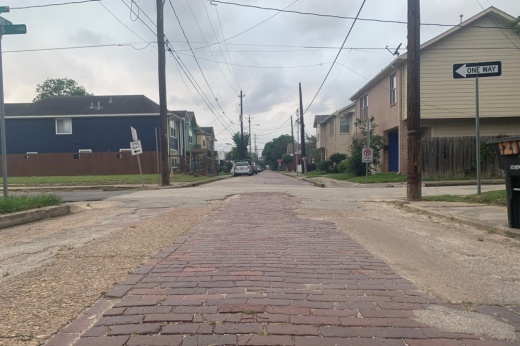Details are emerging on a project seeking to improve street surfaces and underground infrastructure along two historic streets in Freedmen's Town, with project officials emphasizing the importance of preserving the town's historic brick streets.
What happened
Officials with the Houston Public Works Department and TEI Planning + Design—the engineering firm brought on to lead the development of a design concept report—gave updates on the project at an April 23 community meeting.
The project targets the portion of two one-way streets: Andrews Street from Genesee Street to I-45 and Wilson Street from Dallas to Andrews streets. The creation of the design concept report, or DCR, is considered the first step in a three step process, coming before design and construction.
The backstory
Freedmen's Town was founded by freed African Americans shortly after the emancipation of slavery in Texas in 1865, with early founders laying the bricks by hand for the streets that run throughout the community.
Over time, the town's original footprint was reduced as development occurred in the area, according to Texas State Historical Association. Freedmen's Town was listed in the National Register of Historic Places in 1985.
The latest
The DCR was prioritized for the Freedmen's Town project as a way to ensure more robust planning and community engagement, said Donald Buaku, a planner and manager with Houston Public Works. Although it does not result in engineering drawings, it does involve:
- Working with subject matter experts
- Examining existing conditions and work previously done in the area
- Coming up with different alternatives for how the project can move forward
Geoff Carleton, a senior principal with TEI, said preserving the town's historic bricks is considered a top priority. In addition to existing bricks, he said more bricks from the time period could be brought in from city of Houston storage to fill in gaps.
Details on how many additional bricks could be brought in are to be determined, Carleton said. For the parts of the road where asphalt was laid down, Carleton said it is unknown the extent to which historic bricks are underneath the asphalt.
Bricks found in sidewalks elsewhere in the community, including along Richmond Avenue, could have originated from Freedmen's Town, Carleton said. Officials are working with subject matter experts to determine the origin of the bricks and, if they do come from Freedmen's Town, how they could be relocated back into the community as part of this project.
Other project goals include:
- Upgrading underground utilities, some of which are more than 100 years old and contribute to street flooding issues, to current standards
- Improving walkability
- Designating street car tracks in a way that recognizes their historical significance
- Creating other opportunities to tell the story of Freedmen’s Town
The process of preserving the historic bricks has involved a visual assessment almost by the square foot, Carleton said. Thus far, the process has not involved actually touching or digging up any bricks, he said. Once that process starts, the city of Houston has committed to bringing a cultural monitor on board to oversee the handling of the bricks.
Two alternatives have emerged from the DCR work done so far, each of which could be incorporated at different points within the project scope.
- 1. Minimizing brick disturbance. This alternative could make sense for the 1500-1600 blocks of Andrews, where there are no historic street car tracks and a large amount of bricks are in good condition, as well as in front of historic buildings like the Yates House.
- 2. Largely rebuilding the street with a new foundation. Where this alternative is implemented, crews would take out bricks and care for them before placing them back.
Throughout the project, officials will try to consolidate above ground utility poles while putting underground utility lines away from historic bricks, including under the sidewalk or where the street car lines run.
Some residents who attended the April 23 meeting urged planners to be considerate of the space needed for trash and recycling vehicles to navigate the town's narrow streets and intersections.
Also of note
Other design options are being considered with an eye toward highlighting the community's history, including:
- Blue tile street names
- Sidewalk material accents and inlays that could potentially be used to tell stories related to Freedmen's town
- Ways to designate the historic street car track, an area where officials are still gathering feedback
- Street lighting styles
- Street signs styles
- Street scape elements, such as benches, trash cans and bike racks
- Landscaping
What they're saying
Elmo Johnson, a Freedmen's Town resident since 1977 and pastor of Rose of Sharon Baptist Church on Valentine Street since 1984, said the work being planned is long overdue.
"I commend the city on bringing the community out to look at what's happening," he said. "I'm glad that the last couple of mayors have had the interest to bring people together and put a plan together. They have a good plan together, and the community engagement has been great."
Johnson said he thought some of the most crucial elements of the work will involve the installation of better street lighting and green spaces, which he said will facilitate the gathering of community members and allow people to feel safer when walking at night.
What's next
Buaku said officials are hoping to be done with the DCR in May, around which point a preferred alternative and cost estimates for the work will be released. The design process will follow, including the procurement of a consultant, which could take 8-12 months. The actual design work could take another year.
Once construction begins, Buaku said it could take 18-24 months based on which alternative is selected.





